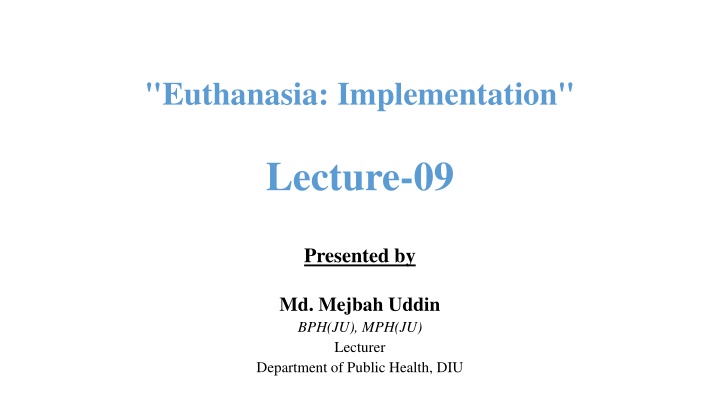
Ethical Guidelines for Implementing Euthanasia Safely and Responsibly
Explore the crucial aspects of implementing euthanasia, including legal frameworks, ethical considerations, medical standards, social sensitivity, safeguards against abuse, and psychological support. Learn how to balance patient autonomy with the sanctity of life while ensuring regulatory oversight, palliative care alternatives, and community engagement.
Download Presentation

Please find below an Image/Link to download the presentation.
The content on the website is provided AS IS for your information and personal use only. It may not be sold, licensed, or shared on other websites without obtaining consent from the author. If you encounter any issues during the download, it is possible that the publisher has removed the file from their server.
You are allowed to download the files provided on this website for personal or commercial use, subject to the condition that they are used lawfully. All files are the property of their respective owners.
The content on the website is provided AS IS for your information and personal use only. It may not be sold, licensed, or shared on other websites without obtaining consent from the author.
E N D
Presentation Transcript
"Euthanasia: Implementation" Lecture-09 Presented by Md. Mejbah Uddin BPH(JU), MPH(JU) Lecturer Department of Public Health, DIU
Legal Framework Establish Clear Laws: Implementing euthanasia should start with a robust legal framework outlining eligibility, procedures, and safeguards. Regulatory Oversight: Independent review boards should oversee cases to ensure all criteria are met and prevent misuse or coercion.
Ethical Guidelines Respect for Autonomy vs. Sanctity of Life: Euthanasia critics argue that while it respects patient autonomy, it challenges the intrinsic value of life. Implementation should balance these perspectives by promoting patient rights while protecting vulnerable populations. Palliative Care Alternatives: Critics suggest enhancing palliative care to reduce requests for euthanasia by improving pain management and psychological support.
Medical Standards Professional Training: Healthcare providers need training to understand the ethical, legal, and psychological aspects of euthanasia. Informed Consent: Ensure thorough and voluntary informed consent processes to address concerns about patient capacity and decision- making.
Social and Cultural Sensitivity Community Engagement: Engage with diverse communities to understand cultural attitudes and adapt practices respectfully. Public Discourse: Foster open conversations to address fears and misconceptions while respecting different moral and religious views.
Safeguards Against Abuse Strict Criteria: Limit eligibility to cases where patients have terminal or unbearable conditions that meet specific criteria. Second Opinions: Mandate independent medical evaluations to confirm the diagnosis and prognosis. Documentation and Transparency: Keep detailed records and provide transparency to ensure trust in the system.
Psychological and Emotional Considerations Support for Patients and Families: Provide counseling and support services for patients considering euthanasia and their families to help them cope with the decision and aftermath. Healthcare Provider Support: Implement programs to support medical staff involved in euthanasia to prevent emotional and ethical distress.
Common barriers and challenges to the implementation of euthanasia Legal Restrictions: Laws in many countries prohibit euthanasia, making it illegal and punishable by law. Ethical Concerns: Ethical debates revolve around the morality of taking a life, even with consent, leading to strong opposition. Religious Beliefs: Many religious groups believe that life is sacred and that only a higher power has the right to end it. Public Opinion: Societal attitudes vary, and negative public perception can create resistance to legalizing euthanasia. Medical Professional Resistance: Some healthcare professionals may refuse to participate due to personal, moral, or professional beliefs.
Risk of Abuse: Concerns about potential misuse or coercion can make lawmakers and citizens hesitant to support euthanasia. Lack of Clear Guidelines: Implementing euthanasia requires detailed protocols, which can be difficult to establish and standardize. Emotional and Psychological Impact: Patients, families, and healthcare providers may face significant emotional and psychological burdens related to euthanasia decisions. Palliative Care Availability: Critics argue that better access to palliative care might reduce the demand for euthanasia, challenging its necessity. Assessment Challenges: Accurately determining a patient's consent and mental capacity to make such a serious decision can be complex and subjective.
Common barriers and challenges to the implementation of euthanasia in BD Cultural Beliefs: Many people in Bangladesh hold strong cultural and religious beliefs that consider euthanasia as morally wrong. These views are deeply rooted in traditions and religious teachings. Legal Restrictions: Euthanasia is illegal in Bangladesh, and there are no laws in place to allow for its practice. Changing the legal framework would require significant reform. Ethical Concerns: There are concerns about the ethical implications of allowing euthanasia, including the potential for abuse and the question of who decides when life should end. Healthcare Infrastructure: The healthcare system in Bangladesh faces challenges in providing adequate palliative care. Without proper end-of-life care options, euthanasia may be seen as a last resort. Lack of Awareness: Many people in Bangladesh are not fully aware of euthanasia and its potential benefits, making it difficult to have open discussions or gain public support for its implementation.



















